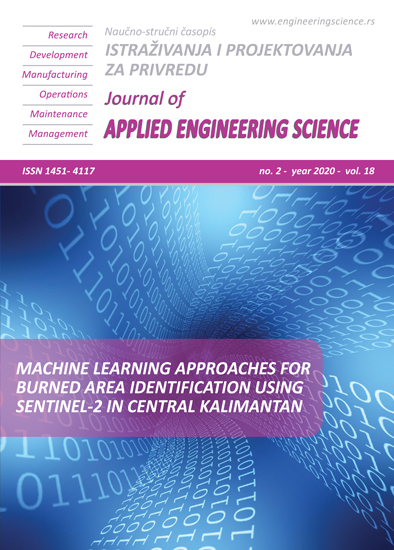APPLICATION OF NEURAL SIMULATION METHODS FOR TECHNOLOGICAL PARAMETERS IDENTIFICATION OF COMPOSITE PRODUCTS INJECTION MOLDING PROCESS
Abstract
The article presents the research results of technological parameters of composite material products manufacturing by the injection transfer molding method using automated tools of preproduction engineering. For the verification of computer simulation results, experimental studies have been carried out on the injection-molding machine for products from fibrous polymer composite materials. The conducted comparative analysis of calculated and actual values of impregnation technological parameters has led us to the conclusion that for the effective application of the modern software for preproduction engineering of composite products it may be necessary to make a joint correction of the input data used for the calculation obtained from the preliminary independent experimental research of the complex of properties for each used component of the composite material. For the joint correction of the input data used for the calculation and improvement of the efficiency of automation systems for the preproduction engineering of composite products, the concept of the neural simulation tools application for the technological process of composite products manufacturing by injection molding methods has been proposed. For training and testing of the neural model, experimental studies of the impregnation of the products with the surface curvature of the second-order have been conducted. The optimization problem was solved by forecasting the front movement of the technical fluid in the volume of preforms during transfer molding.
References
[2] Laurenzi, S., Marchetti, M. (2012). Advanced Composite Materials by Resin Transfer Molding for Aerospace Applications. Composites and Their Properties. doi: 10.5772/48172
[3] Sozer, E.M., Simacek, P., Advani, S.G. (2012). Resin transfer molding (RTM) in polymer matrix composites. Manufacturing Techniques for Polymer Matrix Composites (PMCs), 245–309. doi: 10.1533/9780857096258.3.243
[4] Wang, J., Simacek, P., Advani, S.G. (2016). Use of Centroidal Voronoi Diagram to find optimal gate locations to minimize mold-filling time in resin transfer molding. Composites Part A: Applied Science and Manufacturing, 87, 243–255. doi: 10.1016/j.compositesa.2016.04.026
[5] Kutsbakh, A.A., Muranov, A.N., Semenov, A.B., Semenov, B.I. (2019). Outstanding problems of numerical simulation of the process of injection molding of PIM-feedstocks and component quality. IOP Conference Series: Materials Science and Engineering, 525, 012031. doi: 10.1088/1757-899x/525/1/012031
[6] Alexandrov, I.A., Sheptunov, S.A., Sannikov, A.S. (2019). Some Approaches to the Formalization Principles of Achieving the Target Properties of Products in the Automation of Technological Processes in Mechanical Engineering. 2019 International Conference “Quality Management, Transport and Information Security, Information Technologies” (IT&QM&IS). doi: 10.1109/itqmis.2019.8928338
[7] Engineering Software (CAD, CAM, CAE, AEC, & EDA) Market Business Trends 2020 – Global Industry Types, Applications, Global Market Size, Share, Revenue and Growth Forecast to 2026 by Industry Research.co. https://www.marketwatch.com/press-release/engineering-software-cad-cam-cae-aec-eda-market-business-trends-2020-global-industry-types-applications-global-market-size-share-revenue-and-growth-forecast-to-2026-by-industry-researchco-2020-01-15
[8] Golovatov, D., Mikhaylov, M., Bosov, A. (2016). Optimization of Technological Parameters of Impregnation of Load-Bearing Rod Elements of Reflector made of Polymer Composite Materials by Transfer Molding Method. Indian Journal of Science and Technology, 9(46). doi: 10.17485/ijst/2016/v9i46/107492
[9] Ravey, C., Ruiz, E., Trochu, F. (2014). Determination of the optimal impregnation velocity in Resin Transfer Molding by capillary rise experiments and infrared thermography. Composites Science and Technology, 99, 96–102. doi: 10.1016/j.compscitech.2014.05.019
[10] Semenov, A.B., Kutsbakh, A.A., Muranov, A.N., Semenov, B.I. (2019). Development of a Technique to Simulate the Injection Molding of Metallic-Powder-Filled Polymers. Russian Metallurgy (Metally), 2019(13), 1351–1356. doi: 10.1134/s0036029519130330
[11] Golovatov, D., Mikhaylov, M., Bosov, A. (2016). Analysis of Temperature Fields Distribution in the Technological Tooling for Transfer Molding. Indian Journal of Science and Technology, 9(46). doi: 10.17485/ijst/2016/v9i46/107494
[12] Alexandrov, I.A., Kapitanov, A.V., Muranov, A.N., Egorov, S.B., Tatarkanov, A.A.(2019). Research of Formal-Kinetic Regularities of the Curing Process of Low-Viscosity Epoxy Binder. International Journal of Innovative Technology and Exploring Engineering. 9(2), 1168–1173. doi: 10.35940/ijitee.b7662.129219
[13] Maung, P.P., Htet, T.L., Malysheva, G.V. (2020). Simulation and optimization of vacuum assisted resin infusion process for large-sized structures made of carbon fiber-reinforced plastics. IOP Conference Series: Materials Science and Engineering, 709, 022041. doi: 10.1088/1757-899x/709/2/022041
[14] Maung, P.P., Malysheva, G. (2019). Modeling the effect of fabric weaving pattern on the kinetics of the impregnation process in the manufacturing of the fiber reinforced plastic structures. XLIII Academic Space Conference: Dedicated to the Memory of Academician S.P. Korolev and Other Outstanding Russian Scientists – Pioneers of Space Exploration. doi: 10.1063/1.5133366
[15] Golovatov, D.A., Tatarkanov, A.A., Shavaev, A.A., Gusev, S.A. (2019). The Use of Modern Information Technology in Predicting the Process of Impregnating Composite Preforms with Polymer Resins. 2019 International Conference “Quality Management, Transport and Information Security, Information Technologies” (IT&QM&IS). doi: 10.1109/itqmis.2019.8928415
[16] Ageyeva, T., Horváth, S., Kovács, J.G. (2019). In-Mold Sensors for Injection Molding: On the Way to Industry 4.0. Sensors, 19(16), 3551. doi: 10.3390/s19163551
[17] Kang, P.S., Lim, J.S., Huh, C. (2012). Efficient Viscosity Evaluation Using Artificial Neural Network for Application of EOR Polymer with pH Control. 74th EAGE Conference and Exhibition Incorporating EUROPEC 2012. doi: 10.3997/2214-4609.20148646
[18] Zhang, Z., Friedrich, K. (2003). Artificial neural networks applied to polymer composites: a review. Composites Science and Technology, 63(14), 2029–2044. doi: 10.1016/s0266-3538(03)00106-4
[19] Sheptunov, S.A., Alexandrov, I.A., Golovatov, D.A., Glashev, R.M. (2018). Simulation of Thermoset Heat Conductivity by Means of Artificial Neural Networks. 2018 IEEE International Conference “Quality Management, Transport and Information Security, Information Technologies” (IT&QM&IS). doi: 10.1109/itmqis.2018.8524984
[20] Deep Learning Toolbox – MATLAB.: www.mathworks.com/products/deep-learning.html
[21] Mishra, S., Prusty, R., Hota, P.K. (2015). Analysis of Levenberg-Marquardt and Scaled Conjugate gradient training algorithms for artificial neural network based LS and MMSE estimated channel equalizers. 2015 International Conference on Man and Machine Interfacing (MAMI). doi:10.1109/mami.2015.7456617

